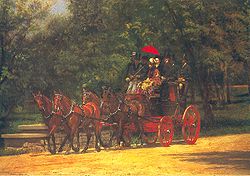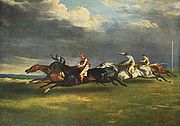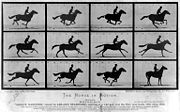
The Fairman Rogers Four-in-Hand
Encyclopedia

Thomas Eakins
Thomas Cowperthwait Eakins was an American realist painter, photographer, sculptor, and fine arts educator...
. It shows Fairman Rogers
Fairman Rogers
Fairman Rogers was an American civil engineer, educator, and philanthropist, born in Philadelphia, Pennsylvania....
driving a coaching party in his four-in-hand carriage
Four-in-hand (carriage)
A four-in-hand is a carriage drawn by a team of four horses having the reins rigged in such a way that it can be driven by a single driver. The stagecoach and the tally-ho are usually four-in-hand coaches....
through Philadelphia's Fairmount Park
Fairmount Park
Fairmount Park is the municipal park system of Philadelphia, Pennsylvania. It consists of 63 parks, with , all overseen by the Philadelphia Department of Parks and Recreation, successor to the Fairmount Park Commission in 2010.-Fairmount Park proper:...
. It is thought to be the first painting to examine precisely, through systematic photographic analysis, how horses move
Horse gait
Horse gaits are the various ways in which a horse can move, either naturally or as a result of specialized training by humans.-Classification:...
.
The Fairman Rogers Four-in-Hand is in the permanent collection of the Philadelphia Museum of Art
Philadelphia Museum of Art
The Philadelphia Museum of Art is among the largest art museums in the United States. It is located at the west end of the Benjamin Franklin Parkway in Philadelphia's Fairmount Park. The Museum was established in 1876 in conjunction with the Centennial Exposition of the same year...
.
Rogers
Eakins taught at the Pennsylvania Academy of the Fine ArtsPennsylvania Academy of the Fine Arts
The Pennsylvania Academy of the Fine Arts is a museum and art school in Philadelphia, Pennsylvania. It was founded in 1805 and is the oldest art museum and school in the United States. The academy's museum is internationally known for its collections of 19th and 20th century American paintings,...
, where Rogers was a Board member and chairman of the Committee on Instruction. Rogers recruited Eakins back to the Academy in 1878 and commissioned the painting from his new instructor.
Independently wealthy, Rogers was a civil engineer
Civil engineer
A civil engineer is a person who practices civil engineering; the application of planning, designing, constructing, maintaining, and operating infrastructures while protecting the public and environmental health, as well as improving existing infrastructures that have been neglected.Originally, a...
and retired professor at the University of Pennsylvania
University of Pennsylvania
The University of Pennsylvania is a private, Ivy League university located in Philadelphia, Pennsylvania, United States. Penn is the fourth-oldest institution of higher education in the United States,Penn is the fourth-oldest using the founding dates claimed by each institution...
. He was an avid coaching enthusiast, founder of the Philadelphia Coaching Club and author of the still-definitive guide to the sport: A Manual of Coaching (Philadelphia: 1900). In the painting, Eakins combined Rogers's love of science with his love of coaching.
Muybridge


Eadweard Muybridge
Eadweard J. Muybridge was an English photographer who spent much of his life in the United States. He is known for his pioneering work on animal locomotion which used multiple cameras to capture motion, and his zoopraxiscope, a device for projecting motion pictures that pre-dated the flexible...
's ground-breaking work in photographing the movement of horses in motion. In 1877, Muybridge published an instantaneous photograph of the racehorse "Occident", showing for the first time just when all four hooves of a galloping horse left the ground. It was commonly taken for granted that the horse has a period of suspension in the gallop, but, as illustrated here, they thought it was in the extended phase of the stride. Muybridge demonstrated that it was in the contracted phase. The following year he conducted an experiment that became one of the seminal events in the history of motion pictures: Sallie Gardner at a Gallop
Sallie Gardner at a Gallop
Sallie Gardner at a Gallop was an early production experiment on June 19, 1878 that led to the development of motion pictures. The motion picture consists of 24 photographs in a fast-motion series that were shown on a zoopraxiscope. The photographs were taken by Eadweard Muybridge, who was...
.
On June 19, 1878, at a racetrack in Palo Alto, California
Palo Alto, California
Palo Alto is a California charter city located in the northwest corner of Santa Clara County, in the San Francisco Bay Area of California, United States. The city shares its borders with East Palo Alto, Mountain View, Los Altos, Los Altos Hills, Stanford, Portola Valley, and Menlo Park. It is...
, Muybridge positioned a row of 24 cameras set close together at regular intervals, each with a trip wire crossing the track. When the racehorse "Sallie Gardner" galloped past the cameras she tripped the wires, resulting in a short but regular sequence of instantaneous photographs shot close to 1/25 of a second apart.
Eakins studied Muybridge's published photographs and taught the new discoveries to his students at the Pennsylvania Academy of the Fine Arts
Pennsylvania Academy of the Fine Arts
The Pennsylvania Academy of the Fine Arts is a museum and art school in Philadelphia, Pennsylvania. It was founded in 1805 and is the oldest art museum and school in the United States. The academy's museum is internationally known for its collections of 19th and 20th century American paintings,...
. According to Eakins biographer Gordon Hendricks, seven years before Sallie Gardner was published, Rogers had attempted to photograph his own horses in motion using a camera with a shutter that rapidly opened and closed (like a Venetian blind). In 1879, Muybridge invited Rogers to witness his further experiments in California — a 7-day train ride from Philadelphia — but Rogers chose to spend the summer in Newport, Rhode Island
Newport, Rhode Island
Newport is a city on Aquidneck Island in Newport County, Rhode Island, United States, about south of Providence. Known as a New England summer resort and for the famous Newport Mansions, it is the home of Salve Regina University and Naval Station Newport which houses the United States Naval War...
.
Under Rogers's sponsorship, Muybridge later moved to Philadelphia and continue his experiments at the University of Pennsylvania
University of Pennsylvania
The University of Pennsylvania is a private, Ivy League university located in Philadelphia, Pennsylvania, United States. Penn is the fourth-oldest institution of higher education in the United States,Penn is the fourth-oldest using the founding dates claimed by each institution...
.
Eakins

.jpg)
Sulky
A sulky is a lightweight cart having two wheels and a seat for the driver only but usually without a body, generally pulled by horses or dogs, and is used for harness races...
. Eakins painted individual studies of Rogers's horses, possibly both in Newport and Philadelphia. A year earlier, he dissected a horse with his Academy students, and may have relied on those anatomical notes. In the sketch, the animal's hooves are more tentative than in the finished painting. Eakins painted a replica of the sketch that he made into a fan for Mrs. Rogers (private collection).
Eakins set the finished painting in Philadelphia's Fairmount Park
Fairmount Park
Fairmount Park is the municipal park system of Philadelphia, Pennsylvania. It consists of 63 parks, with , all overseen by the Philadelphia Department of Parks and Recreation, successor to the Fairmount Park Commission in 2010.-Fairmount Park proper:...
, at a location just north of Memorial Hall
Memorial Hall (Philadelphia)
Memorial Hall, designed by Herman J. Schwarzmann for the 1876 Centennial Exposition in Philadelphia, Pennsylvania, is an early example of monumental Beaux-Arts architecture in the United States. Schwarzmann, the chief engineer of the Fairmount Park Commission, also designed the temporary...
. He populated the work with more figures and inverted the coach's direction so as to set it at a sharper angle which better showed the horses' hooves. The sketch shows Rogers, one passenger and a groom. The painting shows Mr. and Mrs. Rogers, four passengers on a bench behind them and two grooms at the rear of the coach. Eakins likely made studies of each of the people; two of these studies survive. He worked through the fall and winter of 1879 through to the following spring. Theodor Siegl conjectures that the landscaped background may have been the last element to be painted, possibly in as late as May 1880.
Once resolved to show the horses' hooves frozen in motion, Eakins was confronted with the problem of the coach's wheels. In the sketch, he blurred the spokes of the wheels, the traditional way for artists to indicate motion, but this conflicted with his intention to show an instantaneous view of the hooves. He seems to have gone back and forth about this — artist Joseph Pennell
Joseph Pennell
Joseph Pennell was an American artist and author.-Biography:Born in Philadelphia, and first studied there, but like his compatriot and friend, James McNeill Whistler, he afterwards went to Europe and made his home in London...
reported that Eakins at first "drew every spoke in the wheels, and the whole affair looked as if it had been instantaneously petrified." In the end, Eakins made the same compromise of logic as in the sketch: freezing the horses' hooves, but blurring the spokes of the coach's wheels.
In 1899, Eakins painted a black and white replica to be photographed as an illustration for Rogers's A Manual of Coaching (1900).
Critical reception
Rogers paid Eakins $500 for the painting, and exhibited it at the Philadelphia Society of Artists in November 1880. The reviews were respectful, but generally unfavorable, noting the inconsistency between the hooves and spokes, and using this point as a springboard to lecture about the superiority of Art over Science. Eakins was trying something new and while some understood and appreciated the attempt, when first exhibited the painting was not regarded as successful.According to Hilton Kramer
Hilton Kramer
Hilton Kramer is a U.S. art critic and cultural commentator.Kramer was educated at Syracuse University, Columbia University, Harvard University, Indiana University and the New School for Social Research. He worked as the editor of Arts Magazine, art critic for The Nation, and from 1965 to 1982,...
(1985), "...The Fairman Rogers For-In-Hand is a surpassingly dull painting... The painting lacks what for Eakins was always the essential element in art: moral imperative. Representational accuracy, "scientific" or otherwise, was a necessary co-efficient of this moral imperative in art, but it was not itself a sufficient basis for it."

